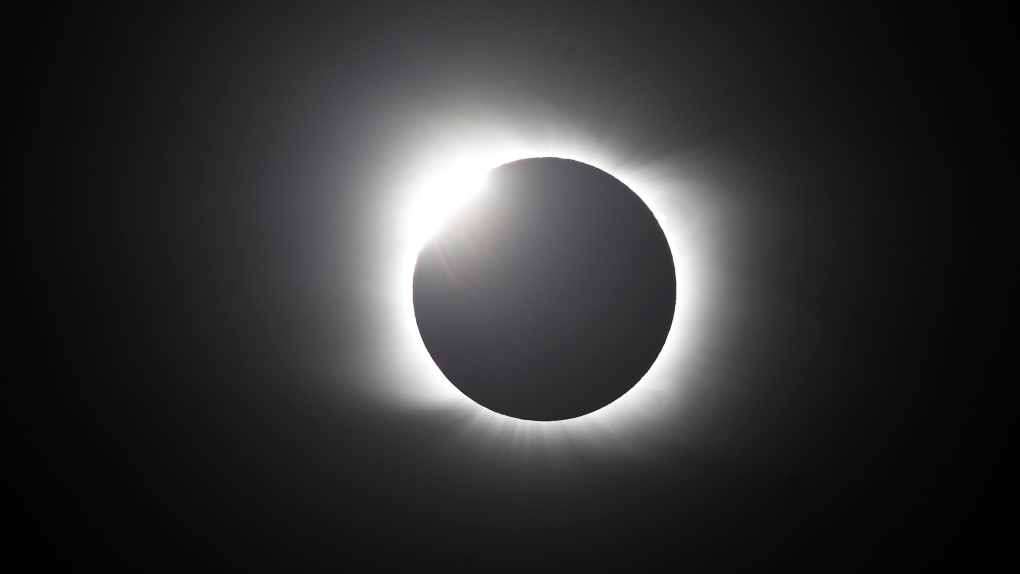TVDSB, LDCSB change date of upcoming PA day to align with rare total solar eclipse
 The moon covers the sun during a total solar eclipse in Piedra del Aguila, Argentina, Monday, Dec. 14, 2020. The total solar eclipse was visible from the northern Patagonia region of Argentina and from Araucania in Chile, and as a partial eclipse from the lower two-thirds of South America. (AP Photo/Natacha Pisarenko)
The moon covers the sun during a total solar eclipse in Piedra del Aguila, Argentina, Monday, Dec. 14, 2020. The total solar eclipse was visible from the northern Patagonia region of Argentina and from Araucania in Chile, and as a partial eclipse from the lower two-thirds of South America. (AP Photo/Natacha Pisarenko)
Local school boards are changing the date of an upcoming PA day in order to align with a rare total solar eclipse, which is set to bathe the region in darkness in early April.
According to the Thames Valley District School Board and the London District Catholic School Board (LDCSB), in alignment with other school boards across the province, a PA day previously scheduled for April 19 will be rescheduled to April 8.
A total solar eclipse will be seen across the region from 2 p.m. until 4 p.m. on April 8, 2024, with the path of totality expected just south of London.
The school boards cite safety concerns, including “diminished levels of daylight and the potential for damaging eye exposure to the sun” for their decision.
The LDCSB said the school board will share educational material and resources with staff and students prior to the eclipse so students can learn more about the rare event.
What is a solar eclipse?
The rare celestial event will see parts of Mexico, the United States and Eastern Canada shrouded in darkness when the moon completely blocks out the sun as it traverses across the sky. Because the sun is 400 times bigger than the moon, but is also 400 times farther away, it makes the two astronomical bodies appear nearly the exact same size, according to NASA.
In our region, multiple communities along Lake Erie will be in the path of 100 per cent totality — including Port Stanley, St. Thomas and Tillsonburg — and therefore the early April event will be a total solar eclipse.
With London situated slightly north, the city will reach 99.5 per cent totality, therefore culminating in a partial solar eclipse.
The moment of absolute totality will be brief however, lasting only approximately two minutes, according to the Canadian Space Agency.
The last time Canada saw a total solar eclipse was February 1979.
How can I view the eclipse?
According to CTVNews.ca, looking at the sun without protection can cause retinal burns and vision loss. It is only safe to remove eye protection in the brief period the sun is completely blocked.
In order to view the eclipse safely, proper eye glasses certified for solar viewing are required. If glasses are unavailable, people can construct a DIY solar eclipse projector. Sunglasses are not safe to use for viewing a solar eclipse.
Additional information on how to safely view a solar eclipse can be found on the Canadian Association of Optometrists website, while additional information on solar eclipses can be found on NASA’s website.
— With files from CTVNews.ca’s Daniel Otis
CTVNews.ca Top Stories

AS IT HAPPENED Wildfire reaches Jasper Wednesday night, causes 'significant loss'
One of two wildfires threatening Jasper National Park reached the townsite Wednesday night and caused 'significant loss.'
Alberta calls in army to assist with wildfire situation
Alberta has called in the Canadian Armed Forces to help assist with the worsening wildfire situation in the province.
Biden explains why he ended re-election bid in Oval Office address
U.S. President Joe Biden on Wednesday delivered a solemn call to voters to defend the country's democracy as he laid out in an Oval Office address his decision to drop his bid for reelection and throw his support behind Vice President Kamala Harris.
Barrie-Innisfil MPP 'blacked-out' and crashed car into window of child care centre
Staff at a Barrie child care centre say they are frustrated by what they call a local MPP's inadequate response after a car crashed through a window in one of the toddler rooms.
Norad intercepts Russian and Chinese bombers operating together near Alaska in apparent first
The North American Aerospace Defence Command (Norad) intercepted two Russian and two Chinese bombers flying near Alaska Wednesday in what appears to be the first time the two countries have been intercepted while operating together.
2 Canadians being 'sent home immediately,' removed from Olympic team after drone incident
An analyst and an assistant coach with Canada Soccer are being removed from the Canadian Olympic Team and 'sent home immediately,' according to the Canadian Olympic Committee.
An unwelcome attendee has joined the Paris Olympic Games: COVID-19
After a handful of Australian water polo players tested positive for COVID-19 this week, questions have emerged around how the spread of the disease will be mitigated at the Summer Olympic Games in Paris.
Vacations, meals, booze: Contractor used $100K of charity's money for personal expenses, B.C. court finds
A B.C. man who was hired to help a non-profit build a food hub but instead spent the money on personal expenses – including travel, restaurants, booze and cannabis – has been ordered to pay more than $120,000 in damages.
Male, female killed, 2 others injured in 'gun battle' outside Toronto plaza: police
Two people are dead and two others suffered serious injuries following a shooting that police have described as a 'gun battle' outside a plaza in Scarborough, Ont. early Wednesday morning.




























